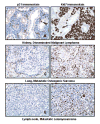Loss of nuclear p21(Cip1/WAF1) during neoplastic progression to metastasis in gamma-irradiated p21 hemizygous mice
- PMID: 17207793
- PMCID: PMC2039892
- DOI: 10.1016/j.yexmp.2006.10.007
Loss of nuclear p21(Cip1/WAF1) during neoplastic progression to metastasis in gamma-irradiated p21 hemizygous mice
Abstract
p21(Cip1/WAF1) localizes to the nucleus in response to gamma-irradiation induced DNA damage and mediates a G(1) checkpoint arrest. Although gamma-irradiated p21(+/-) mice develop a broad spectrum of tumors, gamma-irradiated p21(-/-) mice develop significantly more metastatic cancers. To evaluate the expression of p21 in tissues prone or resistant to tumorigenesis as a function of gamma-irradiation, and to determine whether phenotypic loss of p21 heterozygosity occurs during tumor progression in p21(+/-) mice, tissues and tumors from gamma-irradiated mice were evaluated immunohistochemically. The percentage of tumors in p21(+/-) mice that were nuclear p21-positive declined with progression to metastasis (p<0.0001). Benign tumors were more often p21-positive and comprised of larger subsets of nuclear p21-positive cells than were malignant tumors of the same histopathological type, while metastatic cancers were nuclear p21-negative (p=0.0003). Even when a primary cancer was comprised of a subset of nuclear p21-positive cells, the metastatic foci of that same cancer were nuclear p21-negative. Mesenchymal tumors, though rare, were more likely metastatic than were epithelial tumors (p=0.0004), and these were invariably nuclear p21-negative. Prepubescent epithelial tissues from which most tumors later originated in mice with reduced p21 gene dosage (i.e., harderian gland, ovary, small intestine, and lung) were p21 expressive within 4 h of gamma-irradiation (p=0.0625), so that p21/Ki67 ratios increased post-gamma-irradiation (p=0.03). In contrast, p21 did not localize to nuclei of cortical thymocytes, a tissue where tumorigenesis was not augmented by reduced p21 gene dosage. Cellular subclones of malignant tumors, especially those of mesenchymal cell origin, which lack nuclear p21 may more readily acquire the genetic alterations of the metastatic phenotype.
Figures






References
-
- Morgan DO. Principles of CDK Regulation. Nature. 1995;374:131–134. - PubMed
-
- Sherr CJ, Roberts JM. CDK inhibitors: positive and negative regulators of G1-phase progression. Genes Dev. 1999;13:1501–1512. - PubMed
-
- El-Deiry WS, Tokino T, Velculescu VE, Levy DB, Parsons R, Trent JM, Lin D, Mercer WE, Kinzler KW, Vogelstein B. WAF1, a potential mediator of p53 tumor suppression. Cell. 1993;75:817–825. - PubMed
-
- Brugarolas J, Chandrasekaran C, Gordon JI, Beach D, Jacks T, Hannon GJ. Radiation-induced cell cycle arrest compromised by p21 deficiency. Nature. 1995;377:552–557. - PubMed
Publication types
MeSH terms
Substances
Grants and funding
LinkOut - more resources
Full Text Sources
Molecular Biology Databases

